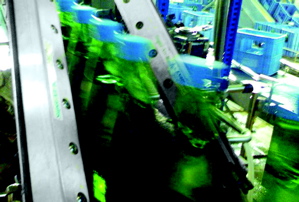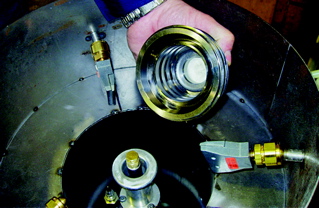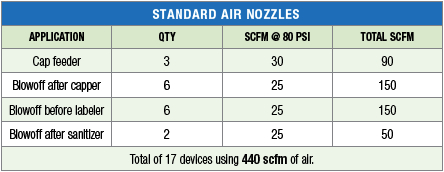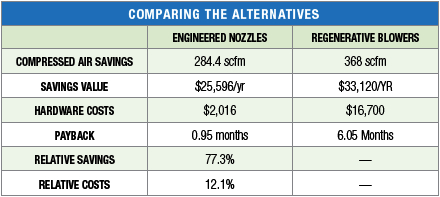Assessing payback on engineered air nozzle and blower upgrades
Background
There are a variety of means factories can use to remove or “blowoff” moisture from a package. Open tubes or drilled pipe are often viewed as simple low-cost methods. However, there are considerable drawbacks to these approaches, most notably – increased operating expense. While they may be convenient and inexpensive in the short term, these approaches often cost 5-7 times more to operate than preferred alternatives. Additionally, they can raise safety concerns for dead ended pressure and ambient noise requirements in order to comply with OSHA guidelines.
 |
"Energy savings are often overlooked in many blowoff applications." |
Beyond the obvious disadvantages with these makeshift components themselves, leaders in the energy conservation field have long advocated that users “take the system approach” to fully optimizes the combined total use of energy. At one extreme, a system that is perfectly efficient yet runs when there is no useful work being done is wasting 100% of the energy it consumes. However more commonly, there can be a single element in the system that can be improved for significant energy savings. The good news is that whether you are able to implement a total system reengineering project or are just looking for a quick fix, opportunities abound in many blowoff applications.
A bird in the hand
In the food and beverage industry particularly, many leading organizations are moving their blowoff applications from compressed air to low pressure, high volume blowers that offer lower operating costs. It can be exciting to consider the latest innovation and understanding the impact of new technology is important in planning future operations. However, be careful not to allow the promise of new technology to distract you from optimizing your current operations.
While there is often a clear winner in terms of energy performance, there is also a corresponding cost to achieve that performance. The costs must always be weighed against the benefits. Don’t allow commitment to an ideal solution to delay meaningful and immediate progress that can be made in smaller steps.
For example, one of the most commonly missed opportunities is the Turn-it-Off principle – a powerful tactic that has yet to achieve its fullest use. There are a number of ways to capture the benefits of Turn-it-Off, either by adopting the practice literally or by incorporating a more automated solution such as an electronic flow control.
As Theodore Roosevelt said “do what you can, with what you have, where you are.” If you have options to improve your existing operations – you should take them. Many organizations have yet to take advantage of low cost options that significantly reduce costs and energy use while holding out for a preferred ideal solution.
Different Priorities
A manufacturing plant can be thought of in terms of two halves – the basic facility infrastructure (plumbing, electrical service, HVAC and compressed air) and the manufacturing equipment purchased from various OEMs and machine builders.
The plant’s priorities include reliability, operational efficiency, cost of maintenance, etc. This responsibility creates a detailed understanding of the facility infrastructure half of the compressed air system: the compressors, dryers, receivers, controls/sequencers, piping, etc. However, the components and equipment that uses the compressed air: air knives, cylinders, actuators, coolers, vacuum generators, etc. - are often designed, specified and supplied by the machine builder with little input from the end user of the equipment. The priority here is process reliability, production throughput and quality – in other words, performance not economy.
While energy use is a growing consideration in machine design these days, the detailed understanding of key performance criteria is rarely known outside of the machine builder’s engineering department. Unless the end user specification addresses energy consumption, standard efficient components are frequently supplied. Once the production equipment arrives at the plant, the emphasis for up-time and production takes over and the associated costs to operate the equipment are generally accepted as fact.
It’s only natural that cost reductions would be secondary to generating revenue, just as losses are secondary to profits in the scorecard of business – the Profit and Loss statement. At the same time, reducing operating cost is part of maximizing bottom line profits. Companies that achieve industry leading performance are able to optimize both sides of the profit and loss equation to yield maximum bottom line results.
Specify high-efficiency components
A key principle for energy intensive equipment is to specify the highest available efficiency of each component of the system. Energy is often the largest factor in Total Cost of Ownership. It can be as high as 96% for electric motors and for compressed air systems; energy is often cited at 82% of lifetime costs. While this may be a more expensive choice initially, utilizing this strategy will maximize overall system efficiency and provide lower operational cost over the long run.
Again, it’s important to take a practical and balanced approach. Is there an opportunity to plan an organized system evolution incorporating next generation technology updates throughout the plant? Or is there anything that can be done with the existing machinery to improve efficiency in the near term? Many simple, short term solutions have payback periods of just one or two months. Don’t overlook this low-hanging fruit while you’re busy mapping out your long term strategy.
Let’s explore two scenarios for the same process application – blowoffs on a bottling line – to illustrate some of the details. One option is to upgrade the compressed air design to utilize a higher efficiency nozzle and reduce compressed air demand. The other option is to eliminate the use of compressed air and change over the system to blower based equipment with lower overall costs.
Scenario A: Compressed Air Nozzle Upgrade
Often, the use of compressed air requires a nozzle to properly shape the air stream for the application. There are a variety of nozzles on the market – each with different performance in terms of force, air consumption and how much noise they produce.
 |
"Engineered air nozzles offer simple but valuable energy savings opportunities." |
As you are working to minimize the compressed air demand in your operation, make note of the types of nozzles in use in your facility and confirm they are providing optimum process and energy performance. Unfortunately, there are no standards to rely on here – you need to verify performance and look for higher efficiency alternatives. Look to your distributor for assistance in making specific comparisons. You may find good opportunity to reduce air demand, noise and operating costs.
Make the most of what you have
I recently worked with a beverage company to examine compressed air usage in their bottling operations. In one bottling line, the following applications were all utilizing standard air nozzles:

Though effective at removing moisture, the standard nozzles use a considerable amount of compressed air. Given that this air flow is on continuously, the annual operating costs are considerable. Assuming a cost of \$0.25/1000 SCFM and a plant that operates 24x5x50, the air costs for this line alone total \$39,600 annually.
The suggested short term alternative outlined below blends compressed air with ambient air to reduce the total demand and consumption of compressed air while still meeting the performance requirements of the application. These alternative devices are sometimes referred to as venturi, air amplification or engineered nozzles.

Selecting engineered nozzles reduces the compressed air requirement by 284.4 SCFM or 64.6%. Assuming the same costs and annual operating hours, these air savings are worth \$25,596 per bottling line, while the costs for the upgrades in this example are just \$2016.
Payback in this upgrade scenario happens very quickly – in just 1 month the operational savings have completely covered the hardware costs. Given that the change utilizes existing piping, the installation costs are minimal. Simply swapping these devices for the original standard efficient ones is all it takes to implement this upgrade.
Scenario B: Upgrade to blower based technology
Low Pressure Air Design
If a new line is being designed, there is a growing preference to use low pressure, high volume air for blowoff applications, i.e. regenerative blowers.
A regenerative blower is a motor powered high volume, low pressure air supply that is suitable for many blowoff applications. A design using regen blowers for the cap feeder and blowoff application example given previously delivers maximum compressed air savings by completely eliminating its use in these applications. In this scenario, a blower rated 175 SCFM @ 4 psi is used in the cap feeder application and another blower rated 300 SCFM @ 3.5 psi is used for the blowoff applications.
This system achieves the greatest savings of compressed air but requires a more involved installation since a greater number of equipment modifications are needed. Note, this solution adds additional motor driven equipment that requires electricity to operate. For the purpose of comparison, this cost will be expressed in terms of the equivalent compressed air – or 72 CFM. So although, the solution eliminates the compressed air entirely, we will subtract the 72 CFM from the 440 CFM and show the savings as 368 CFM as a “net savings”.

The chart above baselines the project for a single bottling line. For a facility with 4 bottling lines, the total savings range from \$102,384 to \$132,480 per year. Each option is a good project, providing meaningful savings with attractive paybacks. Which is the right one for your organization?
Upgrading your compressed air blow-offs has the advantage of lower hardware and installation costs, but it doesn’t completely eliminate the use of compressed air in applications with high run hours. However, this approach does squeeze additional performance from existing equipment and may make sense if you are not in a position to implement an immediate system overhaul.
Migrating from compressed air to blower driven equipment achieves the greatest savings but requires a larger hardware investment and a more involved installation. If the timing is right to leave compressed air behind in your blowoff applications, know that you’ll be achieving a higher level of efficiency as you migrate to blower based solutions.
Regardless of which approach you prefer, consider the total impact. How many lines do you operate? Larger manufacturers operating a network of facilities will often have fleets of existing machinery of similar or even redundant designs. Estimate your total saving potential with either of these options for a single production line or across your total network. It is likely you have an opportunity to achieve meaningful cost and energy savings and do so with a rapid payback.
Don’t delay – get started now!
For more information please contact Ted Clayton, Marketing Manager, Energy and Power Management Services, Kaman Industrial Technologies, ted.clayton@kaman.com, tel: 800-526-2626, www.kamandirect.com
Ted Clayton has over 20 years of experience in engineered and applied product sales with an emphasis on value-based solutions. Ted’s experience working at all levels of manufacturing organizations allows him to define economic value and frame technical solutions that bring meaningful cost reductions in an area of prime importance to a wide variety of industries.




